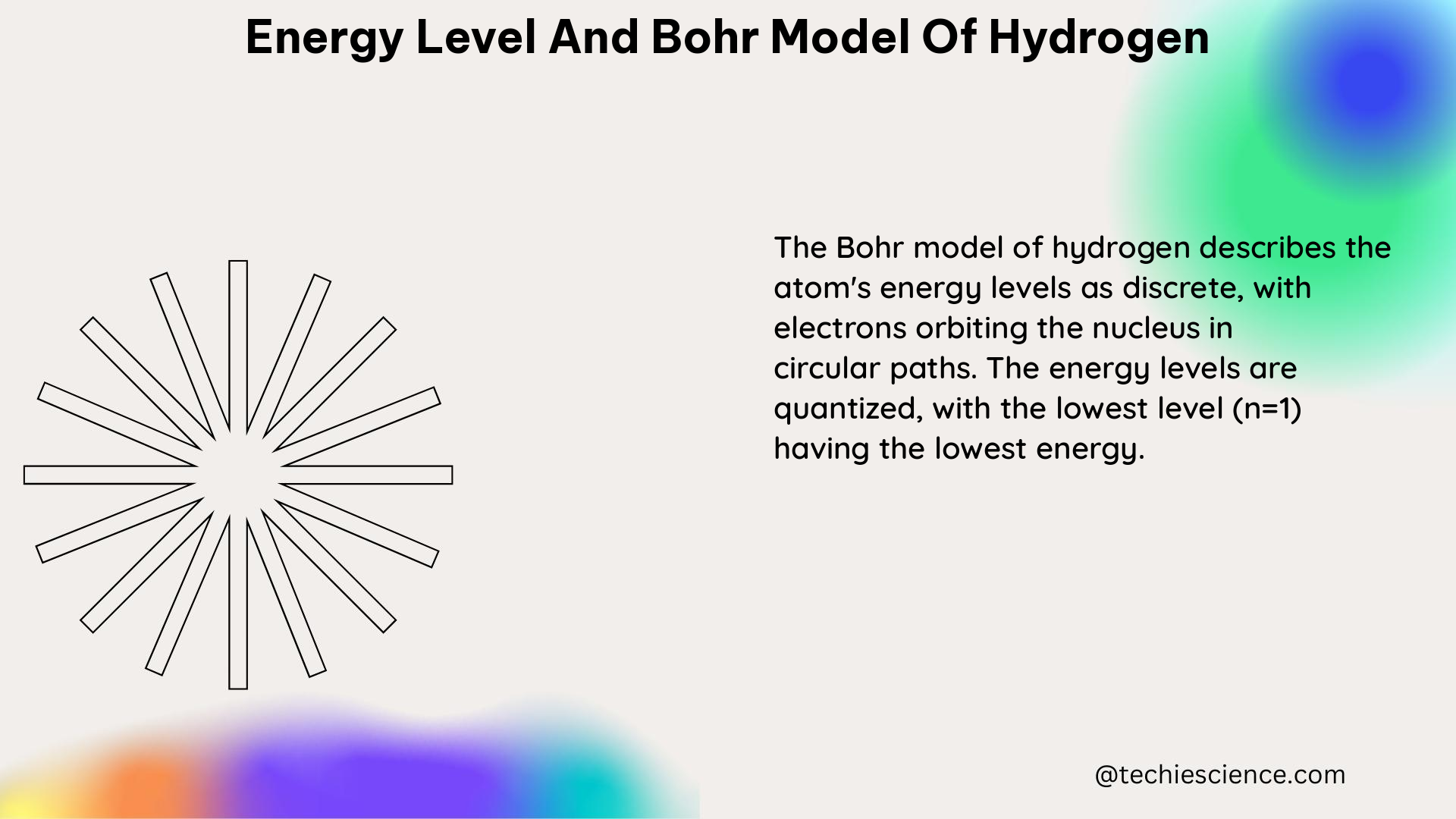The Bohr model of the hydrogen atom provides a fundamental understanding of the behavior of electrons in atoms, particularly the quantization of energy levels and the emission or absorption of specific wavelengths of light. This model, developed by Danish physicist Niels Bohr in 1913, laid the groundwork for our modern understanding of atomic structure and the quantum mechanical nature of electrons.
The Bohr Model: Key Principles
The Bohr model of the hydrogen atom is based on the following key principles:
-
Quantized Energy Levels: Electrons in a hydrogen atom can only occupy specific, discrete energy levels, rather than a continuous range of energies. These energy levels are characterized by the principal quantum number,
n, which is an integer greater than 0. -
Circular Orbits: Electrons in a hydrogen atom move in circular orbits around the nucleus, with each orbit corresponding to a specific energy level.
-
Stable Orbits: Electrons can only occupy stable orbits, where their angular momentum is quantized in units of Planck’s constant,
h. This means that the electrons can only have certain allowed values of angular momentum. -
Emission and Absorption: When an electron transitions from a higher energy level to a lower energy level, it emits a photon with a specific wavelength, determined by the energy difference between the two levels. Conversely, an electron can absorb a photon and transition to a higher energy level.
The Bohr Model Equation

The energy of a hydrogen atom in the nth energy level is given by the Bohr model equation:
E = -13.6 eV / n^2
where E is the energy of the atom in electron volts (eV), and n is the principal quantum number, an integer greater than 0.
Some key points about this equation:
- The negative sign indicates that the electron is bound to the nucleus and has a lower energy than a free electron.
- The energy levels are inversely proportional to the square of the principal quantum number,
n. - The ground state (lowest energy level) of the hydrogen atom corresponds to
n = 1, with an energy of -13.6 eV. - The first excited state corresponds to
n = 2, with an energy of -3.4 eV.
The Rydberg Equation
The wavelength of light emitted or absorbed during a transition between energy levels in a hydrogen atom can be calculated using the Rydberg equation:
1/λ = R(1/n_f^2 - 1/n_i^2)
where:
– λ is the wavelength of the light
– R is the Rydberg constant, approximately 1.097 × 10^7 m^-1
– n_f is the final principal quantum number
– n_i is the initial principal quantum number
This equation allows us to predict the specific wavelengths of light that will be emitted or absorbed by a hydrogen atom during electron transitions between different energy levels.
Hydrogen Atom Transitions and Spectral Series
The transitions between energy levels in a hydrogen atom give rise to the characteristic line spectrum of hydrogen, which consists of several series of spectral lines:
-
Lyman Series: Transitions from higher energy levels (
n > 1) to the ground state (n = 1). The Lyman series is in the ultraviolet region of the electromagnetic spectrum. -
Balmer Series: Transitions from higher energy levels (
n > 2) to the first excited state (n = 2). The Balmer series is in the visible region of the spectrum. -
Paschen Series: Transitions from higher energy levels (
n > 3) to the second excited state (n = 3). The Paschen series is in the near-infrared region. -
Brackett Series: Transitions from higher energy levels (
n > 4) to the third excited state (n = 4). The Brackett series is in the infrared region. -
Pfund Series: Transitions from higher energy levels (
n > 5) to the fourth excited state (n = 5). The Pfund series is also in the infrared region.
These spectral series provide valuable information about the energy levels and structure of the hydrogen atom, and they have been instrumental in the development of quantum mechanics and our understanding of atomic physics.
Limitations of the Bohr Model
While the Bohr model of the hydrogen atom provides a useful framework for understanding the behavior of electrons in atoms, it has several limitations:
-
Applicability: The Bohr model is only accurate for one-electron systems, such as the hydrogen atom. It fails to accurately describe the behavior of multi-electron atoms, where electron-electron interactions and other quantum mechanical effects become important.
-
Orbital Angular Momentum: The Bohr model does not fully account for the orbital angular momentum of electrons, which is a fundamental property in quantum mechanics.
-
Spin and Magnetic Moments: The Bohr model does not consider the spin of electrons or their associated magnetic moments, which are crucial in understanding the fine structure of atomic spectra.
-
Electron Probability Distributions: The Bohr model treats electrons as classical particles orbiting the nucleus, rather than as quantum mechanical wave functions with probability distributions.
Despite these limitations, the Bohr model remains an important stepping stone in the development of quantum mechanics and our understanding of atomic structure. It provides a valuable introduction to the concept of quantized energy levels and the emission and absorption of specific wavelengths of light by atoms.
Conclusion
The Bohr model of the hydrogen atom is a fundamental concept in atomic physics, providing a framework for understanding the behavior of electrons in atoms and the resulting line spectra. By introducing the idea of quantized energy levels and the emission and absorption of photons, the Bohr model laid the groundwork for the development of quantum mechanics and our modern understanding of atomic structure. While the model has its limitations, it remains an important tool for visualizing and explaining the basic principles of atomic physics.
References
- “Bohr Model of an Atom | Overview, Importance & Diagrams” from Study.com
- “Bohr’s Theory of the Hydrogen Atom” from Lumen Learning
- “The Bohr Model of the Atom – Quantized Energy” from Ontario Tech University

I am Subrata, Ph.D. in Engineering, more specifically interested in Nuclear and Energy science related domains. I have multi-domain experience starting from Service Engineer for electronics drives and micro-controller to specialized R&D work. I have worked on various projects, including nuclear fission, fusion to solar photovoltaics, heater design, and other projects. I have a keen interest in the science domain, energy, electronics and instrumentation, and industrial automation, primarily because of the wide range of stimulating problems inherited to this field, and every day it’s changing with industrial demand. Our aim here is to exemplify these unconventional, complex science subjects in an easy and understandable to the point manner.